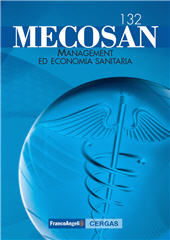Esperienze applicative e implicazioni manageriali per l'Internal Audit nel SSN : Il workshop Control Risk Self Assessment e i successivi sviluppi per il Sistema di Controllo Interno
7-27 p.
L'attività ambulatoriale è uno dei fulcri della produzione delle aziende sanitarie e rappresenta uno dei principali momenti di contatto e cura tra i cittadini e i servizi sanitari. In questa ottica, è fondamentale per le aziende garantire un percorso e un'esperienza di cura che siano volti a ridurre le attese e a massimizzare il tempo a valore per l'utente. La ricerca si è posta l'obiettivo di individuare delle soluzioni organizzative e logistiche volte a ridurre le attese presso il front office centrale del Centro Unico di Prenotazione (CUP) del Presidio Ospedaliero Bassini dell'ASST Nord Milano, mettendo in pratica i principi e le analisi previste dalla teoria delle code. La metodologia utilizzata ha visto un utilizzo combinato di metodi qualitativi e quantitativi.Nello specifico è stato sviluppato un modello statistico che permette di individuare nelle diverse fasce orarie il numero di sportelli ottimale per minimizzare il tempo di attesa degli utenti. I risultati ottenuti sono
stati quantificati con una riduzione del tempo medio di attesa presso il CUP centrale del 45%.Questo risultato è stato raggiunto attraverso diverse soluzioni operative, quali la riorganizzazione delle attività nelle diverse fasce orarie, la definizione e la diffusione di istruzioni operative per gli operatori di front office, nonchè una serie di iniziative volte alla sensibilizzazione e alla formazione del personale coinvolto a diversi livelli. [Testo dell'editore]
The outpatient pathway is one of the most important pipelines for healthcare providers and represents the first point of contact between citizens and healthcare services. Therefore, healthcare organizations need to ensure a patient experience that aims to reduce waiting times andmaximize the value-added time for the user. This research aims to identify organizational and logistics solutions to reduce queues at the central front office for admission, payment, and booking of the Bassini Hospital at ASST Nord Milano, applying the principles and analyses defined by the queuing theory.The methodology was a combination of qualitative and quantitative methods. Specifically, a statistical model was developed to identify the optimal number of front office operators for each hour to minimize users' waiting time. The results obtained can be quantified as a 45% reduction in the average waiting time at the Bassini Hospital front office. This result has been achieved through a number of operational
solutions such as the reorganization of the activities along the different time slots, the definition and dissemination of procedures to front office staff, and a series of initiatives aimed at raising awareness and trainingoperators at all level. [Publisher's Text]
-
Articles from the same issue (available individually)
-
Information
DOI: 10.3280/mesa2024-132oa20676
ISSN: 2384-8804
KEYWORDS
- Internal Auditing, Sistema di Controllo Interno, Control Risk Self Assessment, workshop, Linee Guida regionali, Emilia-Romagna
- Internal Auditing, Internal Control System, Control Risk Self Assessment, Workshop, Regional Guidelines, Emilia-Romagna Region


